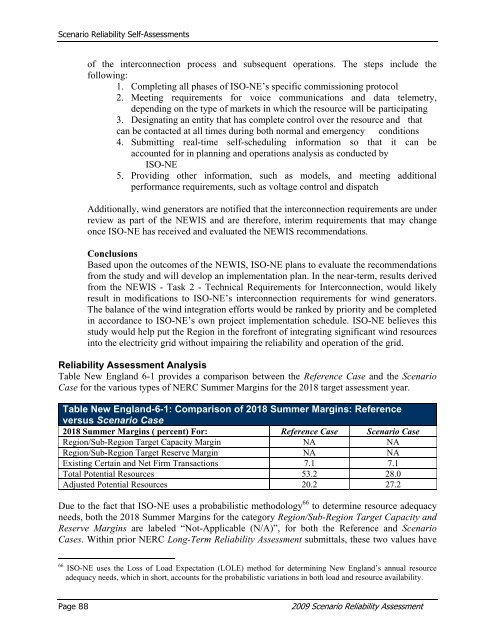2009 Scenario Reliability Assessment - NERC
2009 Scenario Reliability Assessment - NERC
2009 Scenario Reliability Assessment - NERC
- No tags were found...
You also want an ePaper? Increase the reach of your titles
YUMPU automatically turns print PDFs into web optimized ePapers that Google loves.
<strong>Scenario</strong> <strong>Reliability</strong> Self-<strong>Assessment</strong>sof the interconnection process and subsequent operations. The steps include thefollowing:1. Completing all phases of ISO-NE’s specific commissioning protocol2. Meeting requirements for voice communications and data telemetry,depending on the type of markets in which the resource will be participating3. Designating an entity that has complete control over the resource and thatcan be contacted at all times during both normal and emergency conditions4. Submitting real-time self-scheduling information so that it can beaccounted for in planning and operations analysis as conducted byISO-NE5. Providing other information, such as models, and meeting additionalperformance requirements, such as voltage control and dispatchAdditionally, wind generators are notified that the interconnection requirements are underreview as part of the NEWIS and are therefore, interim requirements that may changeonce ISO-NE has received and evaluated the NEWIS recommendations.ConclusionsBased upon the outcomes of the NEWIS, ISO-NE plans to evaluate the recommendationsfrom the study and will develop an implementation plan. In the near-term, results derivedfrom the NEWIS - Task 2 - Technical Requirements for Interconnection, would likelyresult in modifications to ISO-NE’s interconnection requirements for wind generators.The balance of the wind integration efforts would be ranked by priority and be completedin accordance to ISO-NE’s own project implementation schedule. ISO-NE believes thisstudy would help put the Region in the forefront of integrating significant wind resourcesinto the electricity grid without impairing the reliability and operation of the grid.<strong>Reliability</strong> <strong>Assessment</strong> AnalysisTable New England 6-1 provides a comparison between the Reference Case and the <strong>Scenario</strong>Case for the various types of <strong>NERC</strong> Summer Margins for the 2018 target assessment year.Table New England-6-1: Comparison of 2018 Summer Margins: Referenceversus <strong>Scenario</strong> Case2018 Summer Margins ( percent) For: Reference Case <strong>Scenario</strong> CaseRegion/Sub-Region Target Capacity Margin NA NARegion/Sub-Region Target Reserve Margin NA NAExisting Certain and Net Firm Transactions 7.1 7.1Total Potential Resources 53.2 28.0Adjusted Potential Resources 20.2 27.2Due to the fact that ISO-NE uses a probabilistic methodology 66 to determine resource adequacyneeds, both the 2018 Summer Margins for the category Region/Sub-Region Target Capacity andReserve Margins are labeled “Not-Applicable (N/A)”, for both the Reference and <strong>Scenario</strong>Cases. Within prior <strong>NERC</strong> Long-Term <strong>Reliability</strong> <strong>Assessment</strong> submittals, these two values have66 ISO-NE uses the Loss of Load Expectation (LOLE) method for determining New England’s annual resourceadequacy needs, which in short, accounts for the probabilistic variations in both load and resource availability.Page 88<strong>2009</strong> <strong>Scenario</strong> <strong>Reliability</strong> <strong>Assessment</strong>
















